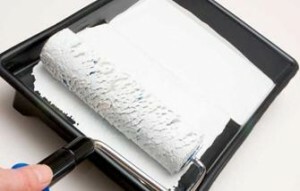Painting decorative plaster: the technology works
Table of contents
- 1 White and colored mixtures
-
2 staining technique
- 2.1 Classic staining method
- 2.2 colors combine
- 3 Summing up
Painting plaster is the final stage of the surface finish. As a result of how well the work is done depends on the overall impression of the building and its appearance.
This step is very important, so this stuff we have been devoting coloring technologies.
 So why paint the plaster?
So why paint the plaster?- Firstly, as we have said above, the coloration will allow you to create a unique image of the design of your interior or facade. The choice of color depends on your imagination and your sense of beauty.
- Second, importantly, the exterior paint protects the decorative plaster, applied by hand.
- In addition, the bright exterior paint prevents excessive heating of the walls of the building on a hot summer day, which will allow you to save money on air conditioning.
As you can see, coloring, in addition to purely design advantages, carries a very practical function. Competent and qualitative coloring to do and so obvious advantages of monolithic plaster even more vivid.
White and colored mixtures
Starting work, you will inevitably come across the question - how to choose a decorative mix: white (suitable for further painting) or color (included in Coloranting component).
Indeed, apart from the actual color, it is possible to apply directly to the wall color formulation. For this purpose, the step of preparing a mixture solution add color and mix thoroughly.
Note! Coloranting component should be selected in the same place where you get a footing. Consider the fact that, after drying, the color will be a tone lighter.

Stucco, tinted
After tinting composition is made, you can start leveling plaster walls.
However, some types of decorative mixture does not provide coloration in the mass.
Therefore, after application, it is necessary to produce color. Used for coloring various interior or exterior paints that are applied directly to the white base.
Furthermore staining white surface, rendering the variant individual sites. This combination is able to give a very interesting design effect.
staining technique
Now that we are sorted into varieties of plaster, it's time to answer the question - how to paint decorative plaster?
Classic staining method
coloring:
- Any work on the painting can begin only after complete drying of the plaster the walls with his own hands. For this purpose, after the formation of the decorative relief on the surface must wait for 8 to 48 hours. Time to complete drying depends on the composition of the mixture.
- If the surface tends to shattering or delamination (sometimes this "sin" a mixture based on cement) in order to strengthen the wall surface treat colorless primer.
- After the primer has dried, proceed directly to staining.
In order to stain not only successfully passed, but with minimal inconvenience, it is necessary to acquire a few devices that greatly facilitate our painting.
-
If we're going to paint roller, it is better to buy a special tray for paint. Pouring paint into a tray, we rid ourselves of the need to scoop up the paint from the jar with a brush and roller attempts to squeeze into the jar.

Tray for paint (price - from 27 rubles).
- Special plate with spikes on the edge of the tray will allow us to quickly and efficiently remove with roller paint excess.
- If you plan on painting brush, avoid splashing paint surplus helps nylon strap stretched over a bucket of paint. This uncomplicated design allows you to quickly remove excess paint from the surface.
Getting to paint indoors, close the floor, furniture, windows and doors slopes ukryvochnym material. For facade plasters for application technology such precautions are not necessary, but the windows and the track near the wall still stands to protect from drops of paint.
colors combine
- The easiest way to color - "in one go". To do this with a brush or roller with a long nap interior decorative trim or plastering the walls outside the building painted over completely, including all recesses and protrusions of the relief.
-
A more complex effect can be achieved by combining different colors and shades of paint. For this purpose, initially paint the wall with a base include the long roller shade (lighter). Give the base layer is completely dry for two hours.

relief painting
- On top of the base layer with a brush with a small amount of ink (so-called technique of "dry brush") or on a short-nap roller relief protrusions plot the darker ink. This technique allows the application to stress relief and makes the surface "volume".
- Instead of dark paint on the protruding relief elements can be applied decorative metallics - gold, silver, bronze. They may be applied as a "dry brush", and using a special gloves, which provides a shading decorative layer and creating a smooth transition between colors.
Note! When applying metallics it is important not to overdo it. gilding surplus may look pretty tasteless, at the same time as a small amount of gold or bronze profitable Otten base color.
The final stage color is a protective paint, which prevents wear of the outer layer.
Summing up
Now that you know how to paint decorative plaster with minimal effort. We hope our article has been helpful to you. In order to more accurately understand the technological and practical issues on our website provides detailed photo and video instruction, in which you will find useful information on the question.
